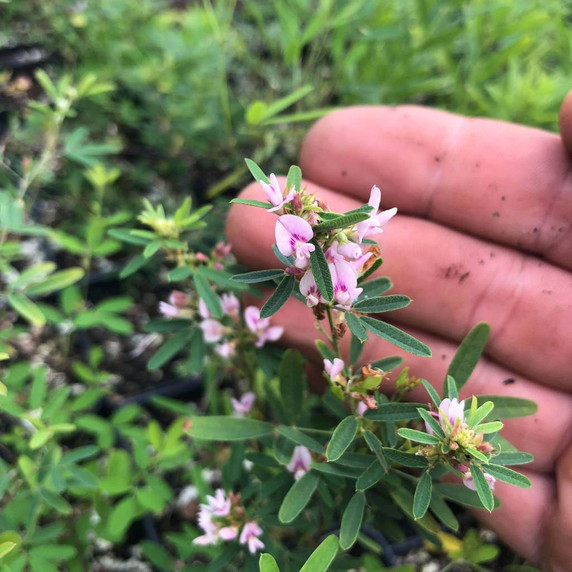
Lespedeza virginica - SLENDER BUSH CLOVER
Slender shrubby looking native perennial with nicely arching branches, small pink flower and great wildlife support.
2' tall x 1.5-2' wide, flowers in July-August/September.
Full sun, part sun, adaptable to soil types, but prefers somewhat drained soil with average moisture (medium) to medium-dry or dry. Loam, sandy, gritty, gravelly, leaner, shallower or also average soil.
Excellent drought tolerance, plant fix nitrogen and can improve poor soils.
Native to eastern USA, see the USDA distribution map. Can be found in black soil, sandy prairies and hill prairies, rocky upland forests and sandy forests, savannas, limestone glades, bluffs, in light oak woods.
Hardy in zones 3 to 9.
Deer and rabbit (and other herbivore mammals) feed on this plant (so it will be difficult to establish, where overpopulated).
Flowers offer nectar and pollen to long-tongued bees, short-tongued bees, flies, small butterflies, and skippers. Host plant for caterpillars of several species of skippers (Southern Cloudywing, Northern Cloudywing, Hoary Edge). The seeds are eaten by Bobwhite and occasionally the Wild Turkey.
Best for naturalistic plantings, pollinator gardens, butterfly gardens, for sunny, drier or well drained soils (bush clover can reseed where happy and also can stabilize soil due to it's roots).
Interesting plant, that has to be placed closer to the front. Combine with native perennials like Asclepias (A. tuberosa, A. verticillata), Antennaria, Dalea, Callirhoe, Coreopsis, Echinacea, Geum triflorum, Liatris, Opuntia, Penstemon, Ruellia, Salvia azurea,Sisirinchium, Verbena stricta and grasses like Bouteloua, Koeleria, Muhlenbergia, Sporobolus.
But also introduced perennials like Geranium sanquineum, Hyssopus, Lavandula, Origanum, Salvia nemorosa, Satureja montana, Sedum, Thymus, smaller Perovskia, ...
Picture copyright : US Perennials Nursery
Pot size : square 3.5" x 5" deep pot

Lespedeza virginica - SLENDER BUSH CLOVER
Slender shrubby looking native perennial with nicely arching branches, small pink flower and great wildlife support.
2' tall x 1.5-2' wide, flowers in July-August/September.
Full sun, part sun, adaptable to soil types, but prefers somewhat drained soil with average moisture (medium) to medium-dry or dry. Loam, sandy, gritty, gravelly, leaner, shallower or also average soil.
Excellent drought tolerance, plant fix nitrogen and can improve poor soils.
Native to eastern USA, see the USDA distribution map. Can be found in black soil, sandy prairies and hill prairies, rocky upland forests and sandy forests, savannas, limestone glades, bluffs, in light oak woods.
Hardy in zones 3 to 9.
Deer and rabbit (and other herbivore mammals) feed on this plant (so it will be difficult to establish, where overpopulated).
Flowers offer nectar and pollen to long-tongued bees, short-tongued bees, flies, small butterflies, and skippers. Host plant for caterpillars of several species of skippers (Southern Cloudywing, Northern Cloudywing, Hoary Edge). The seeds are eaten by Bobwhite and occasionally the Wild Turkey.
Best for naturalistic plantings, pollinator gardens, butterfly gardens, for sunny, drier or well drained soils (bush clover can reseed where happy and also can stabilize soil due to it's roots).
Interesting plant, that has to be placed closer to the front. Combine with native perennials like Asclepias (A. tuberosa, A. verticillata), Antennaria, Dalea, Callirhoe, Coreopsis, Echinacea, Geum triflorum, Liatris, Opuntia, Penstemon, Ruellia, Salvia azurea,Sisirinchium, Verbena stricta and grasses like Bouteloua, Koeleria, Muhlenbergia, Sporobolus.
But also introduced perennials like Geranium sanquineum, Hyssopus, Lavandula, Origanum, Salvia nemorosa, Satureja montana, Sedum, Thymus, smaller Perovskia, ...
Picture copyright : US Perennials Nursery
Pot size : square 3.5" x 5" deep pot







